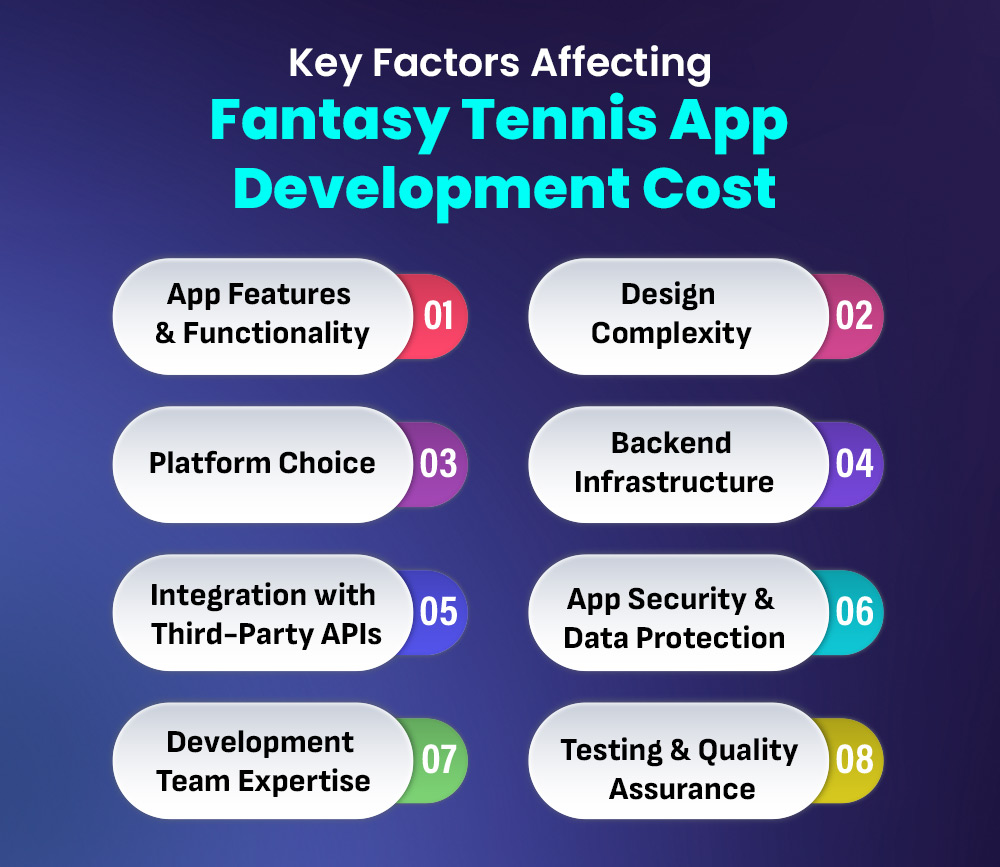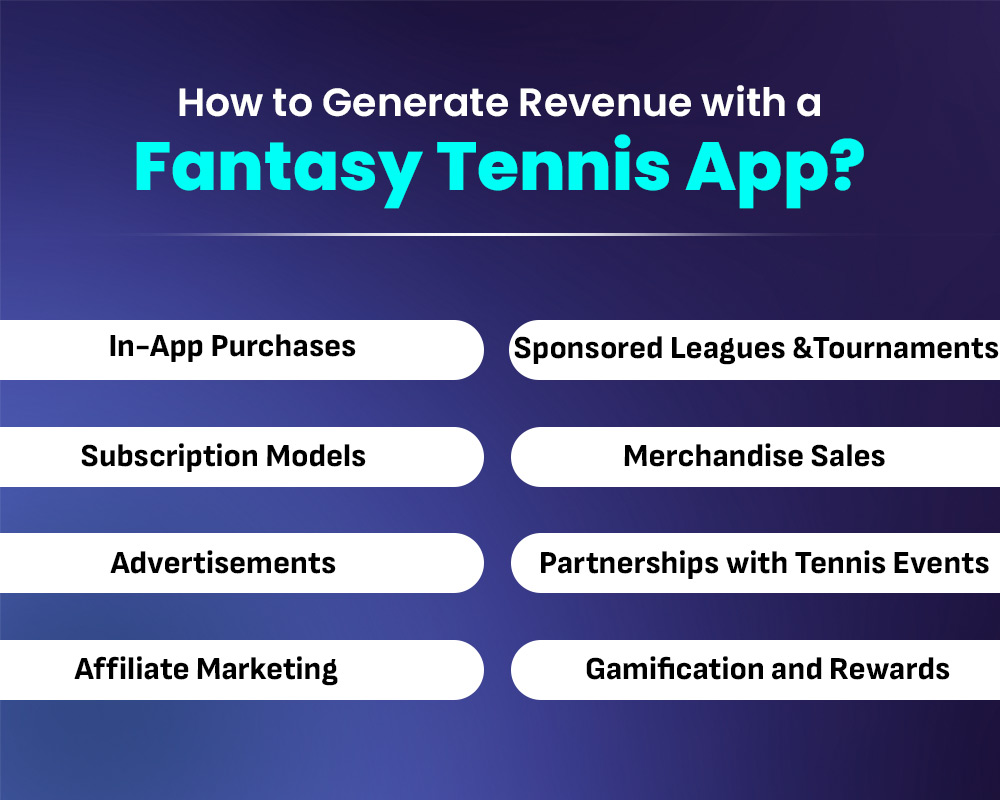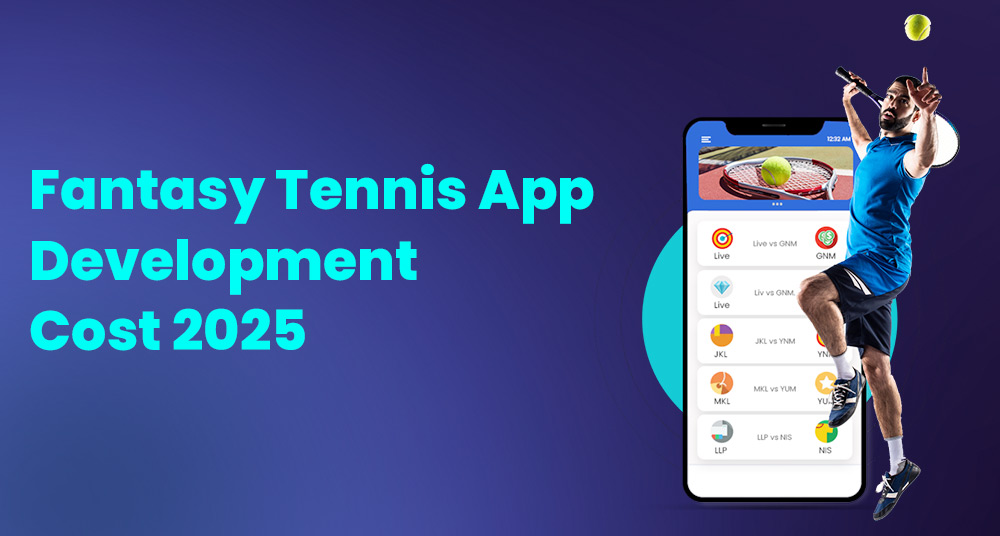As fantasy sports continue to gain popularity, fantasy tennis has emerged as a thrilling way for fans to engage with the sport. However, developing a robust fantasy tennis app involves several stages, each influencing the overall Fantasy Tennis App Development Cost. Whether you’re an entrepreneur looking to create a unique platform or a company interested in expanding into this niche, understanding the various cost factors is crucial. From user interface design to backend development, real-time data integration, and platform security, the price can vary widely depending on features, complexity, and the development team’s expertise. In this guide, we’ll explore the key elements that contribute to fantasy tennis app development cost in 2025, helping you navigate the process more effectively.
What is a Fantasy Tennis App?
A Fantasy Tennis app allows users to create virtual teams of real-life tennis players and compete against others based on their players’ real-world performances in tournaments. Users earn points based on players’ match results, such as wins, aces, and other stats. The app combines the excitement of fantasy sports with the global appeal of tennis, offering fans a chance to engage with the sport in a fun, competitive way.
Key Factors Influencing Fantasy Tennis App Development Cost

The cost of developing a fantasy Tennis app can vary significantly depending on several factors. From app features and design complexity to platform choice and development team expertise, these elements play a critical role in determining the overall price. Understanding these key factors helps ensure a successful and cost-effective development process.
App Features and Functionality
The number and complexity of features directly affect development costs. Features like live score updates, player stats, real-time game data, payment integration, and social sharing increase the overall budget due to the additional technical requirements and backend infrastructure needed.
Design Complexity
A sophisticated, user-friendly UI/UX design adds to the cost of development. If the app requires custom graphics, animations, or an intricate layout, the design process can be more time-consuming and expensive, demanding skilled designers and more development resources.
Platform Choice
The decision to develop for iOS, Android, or both platforms influences cost. Developing a cross-platform app might initially seem more expensive but can ultimately reduce long-term costs. Native apps require separate codebases, making them costlier to develop and maintain.
Backend Infrastructure
A robust backend is essential for real-time data handling, player statistics, and user management. The complexity of your backend infrastructure (servers, databases, APIs) impacts development time and cost. Scalable and secure backends demand specialized expertise and higher budgets.
Integration with Third-Party APIs
Integrating external APIs, such as for live scores, player data, or payment gateways, can raise costs. Third-party API subscriptions, along with the integration and testing processes, add to the complexity of development, as developers must ensure compatibility and stability.
App Security and Data Protection
Fantasy sports apps handle sensitive data such as user details, payments, and player statistics. Implementing robust security features like encryption, two-factor authentication, and secure payment gateways requires expertise and adds to the development cost to ensure a safe user experience.
Development Team Expertise
The skillset and location of your development team significantly affect costs. Highly experienced developers, particularly those with expertise in real-time data processing or mobile gaming, will command higher fees. Offshore teams may offer cost savings, but they could involve communication and quality control challenges.
Testing and Quality Assurance
Thorough testing and quality assurance (QA) ensure the app functions smoothly and remains bug-free. QA processes, including testing for security, performance, and user experience across multiple devices, can add to the development timeline and costs, especially for complex fantasy sports apps.
Fantasy Tennis App Development Cost
The development cost of a Fantasy Tennis app can vary significantly based on several factors, including the complexity of features, platform (iOS, Android, or both), design, and the development team’s location. On average, the cost can range from $7,000 to $150,000.
Basic Features
For a simple app with user registration, match tracking, scoring, and basic fantasy league functionality, development could cost around $7,000–$10,000.
Intermediate Features
Adding real-time updates, in-app purchases, social media integration, advanced analytics, and custom graphics can push the cost to $50,000–$100,000.
Advanced Features
For a sophisticated app with AI-powered predictions, live match streaming, video highlights, multi-language support, and complex back-end systems, the cost may exceed $100,000, potentially reaching up to $150,000 or more.
Ongoing maintenance, updates, and marketing can also add to the overall cost. The choice of developers (freelancers, small agencies, or large firms) will also impact the final price.
How to Make Money with a Fantasy Tennis App?

Fantasy Tennis Software Development offers exciting opportunities to monetize while engaging tennis enthusiasts. With the growing popularity of fantasy sports, tennis presents a unique niche. By offering dynamic features like player statistics, real-time scoring, and engaging fantasy leagues, you can tap into a loyal fanbase and generate revenue through multiple streams such as ads, in-app purchases, and premium memberships.
In-App Purchases
Offer users the option to purchase exclusive content, premium player stats, or advanced analytics. You could also sell virtual items, such as special player cards or boosts that enhance fantasy team performance. This creates an additional revenue stream while offering added value for serious fantasy tennis players.
Subscription Models
Implement a subscription-based model where users pay for premium features, such as advanced scoring, detailed player analytics, or exclusive leagues. Offering tiered subscription plans can cater to casual and serious players, ensuring a steady and scalable revenue stream as users get access to enhanced content and experiences.
Advertisements
Monetize the app with in-app advertisements, such as banner ads, interstitial ads, or video ads. Display ads during match breaks or between user interactions to minimize disruption. Partnerships with relevant brands or tennis sponsors can also help maximize ad revenue, especially if your app attracts a significant user base.
Affiliate Marketing
Partner with tennis-related brands, sports equipment retailers, or online betting platforms to promote their products through affiliate links. You can earn commissions when users click on these links and make a purchase. Affiliate marketing allows you to monetize your app without relying solely on users’ in-app spending.
Sponsored Leagues and Tournaments
Offer sponsored fantasy leagues or tournaments, where brands can sponsor specific competitions within the app. Sponsors could include sports apparel companies, tennis academies, or media outlets. This adds an additional revenue stream while providing sponsors with valuable exposure to a targeted, engaged audience of tennis enthusiasts.
Merchandise Sales
Integrate a merchandise store within the app, offering tennis-related products such as clothing, gear, and accessories. You could even sell app-branded items, such as T-shirts or hats. This creates another revenue stream while building brand loyalty and further connecting your app to the broader tennis culture.
Partnerships with Tennis Events
Partner with tennis tournaments and events (e.g., Grand Slam, ATP, or WTA) to create exclusive fantasy leagues tied to specific matches or seasons. Revenue can be generated through co-branded promotions, cross-marketing, and selling exclusive event-related content or experiences to users who follow the real-world tennis events.
Gamification and Rewards
Incorporate gamification elements like daily challenges, achievements, and leaderboards. Offer virtual rewards or prizes to winners, which could be exchanged for real-world goods, discounts, or app credits. Users are more likely to engage with the app consistently, leading to higher user retention and potential upselling of premium features.
Choosing the Right Fantasy Tennis App Development Company
Choosing the right fantasy tennis app development company is crucial to building a successful and engaging platform. When evaluating potential developers, consider the following key factors:
Expertise in Fantasy Sports
Look for companies with a proven track record in developing fantasy sports apps, particularly those with experience in tennis. A deep understanding of the sport’s nuances and its fanbase is essential for creating an immersive experience.
Technical Proficiency
The fantasy tennis app development company should be skilled in the latest technologies like AI for player stats prediction, real-time updates, and a seamless user interface. They should be able to create cross-platform apps for both iOS and Android.
Customization Options
A top-tier company should offer customizable features to meet your specific business goals. Whether it’s league formats, scoring systems, or user engagement tools, flexibility is key.
Security and Scalability
Ensure the company follows best practices for app security, protecting user data and payment information. The app should also be scalable to handle growing user bases and increased data traffic.
Client Reviews and Portfolio
Check the company’s portfolio and client testimonials. Positive feedback and previous work in the fantasy sports niche can give you confidence in their capabilities.
Selecting the right fantasy tennis app development company is key to creating a platform that meets user expectations and stands out in a competitive market. It’s essential to partner with companies that have a proven track record, a strong technology stack, and a focus on scalability. Leading companies like Fantasy App Solutions, Artoon Solutions, DQOT Solutions, Synarion IT Solutions, and IMG Global Infotech offer comprehensive services that can help you succeed in the rapidly growing fantasy sports industry.
Useful Resource: “Fantasy Golf App Development Cost“
Final Words
In conclusion, the fantasy tennis app development cost in 2025 depends on various factors, including features, design complexity, platform choice, and backend infrastructure. Basic apps may start around $7,000, while more sophisticated platforms with AI, real-time updates, and advanced features can reach $150,000 or more. Monetization strategies such as in-app purchases, subscriptions, and ads offer multiple revenue streams. Choosing the right development company with expertise in fantasy sports and a focus on security and scalability is essential to ensure success. With careful planning, you can create an engaging and profitable fantasy tennis app.



